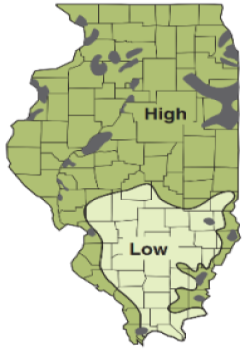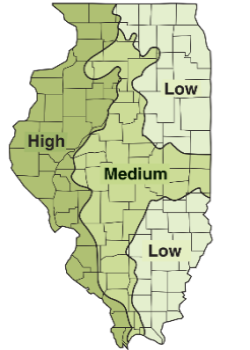Soil health tests are a big conversation topic these days, but there’s a lot of conflicting information out there. Presented by Stacy Zuber, Ph.D., State Soil Health Specialist with USDA Natural Resources Conservation Service, this webinar discusses how soil health tests differ from measuring soil fertility, sampling and handling procedures and how to interpret your results.
Presenter: Stacy Zuber, Ph.D., State Soil Health Specialist with the... Read More →
ILSOYADVISOR POST
Is It Time to Build Nutrient Plans for 2021?
August 18, 2020
Most soybean fields in Illinois are finally at a point where there is not much more a producer can do to protect top end yield. Even though 2020 created early season challenges from planting dates and slow growth in May and June, it has shown our current crop very favorable conditions during the grain fill period.
With 2020 blessedly in the second half, it’s never too early to start planning for the next crop. So I wanted to provide some food for thought to help stimulate ideas for 2021.
1. Understand soil fertility build
Think about the soil “build” as the kitchen pantry. The pantry has multiple shelves where all your food is stored throughout the year. A family ensures all the shelves are full going into winter so if uncontrollable weather events take place you have food to last until you can resupply. However, if you don’t replenish your pantry, the demand may surpass the supply during the next weather event. Soil fertility build is similar; we need to make sure we have all the soil shelves fully stocked.
But how do you know what should be on your grocery list? The University of Illinois agronomy handbook is a great resource showing the different supply levels for phosphorus and potassium throughout the state. The maps below can help farmers better understand the supplying power of their regional soils and how one needs to manage the soils’ fertility build. These values vary throughout the state based off parent material, weathering and the type of clay.


Potassium levels on the left and phosphorus levels on the right.
 2. Nutrient removal from crops
2. Nutrient removal from cropsIn many fields across Illinois, the corn crop tends to get the fertilizer (DAP & POT) application and the leftover is for the following soybean crop. In many situations, the maintenance nutrients supplied to a corn crop were actually based off a lower expected yield. Therefore, higher yielding corn crops can remove additional nutrients from the soil. When this happens, the following soybean crop has a reduced nutrient supply. The charts to the right give some examples of how crop nutrients supply can become unbalanced when trying to meet the demand for a high yielding soybean crop in year two.
3. When to purchase supply
When to buy crop nutrients is almost as important to be aware of as application timing. Like many things in life, a commodity will increase in value when demand increases and the supply is not there to support it. Knowing the best time to buy can alter a financial budget significantly. Do your homework and determine when is the ideal time to purchase. It’s usually always higher to buy “in-season.” It’s never to early to start building your budget for 2021, procuring needs, and locking in supply and price.
There is no doubt that the agriculture industry is going through some crazy and challenging times. However, we still need to make good agronomic decisions with crop nutrients to maximize yield and investments. Now is a great time to start evaluating options for 2021.
Recommendations:
- Review soil tests.
- If it’s time to sample, consider waiting until spring and start sampling all fields in the spring.
- How can you better supply potassium to a soybean crop? Is spring pre-plant an option for you?
- Do the math to determine how much nutrients are being removed from a field by the current crop, and decide if you are spreading enough to offset the removed amount.





Comments
Add new comment